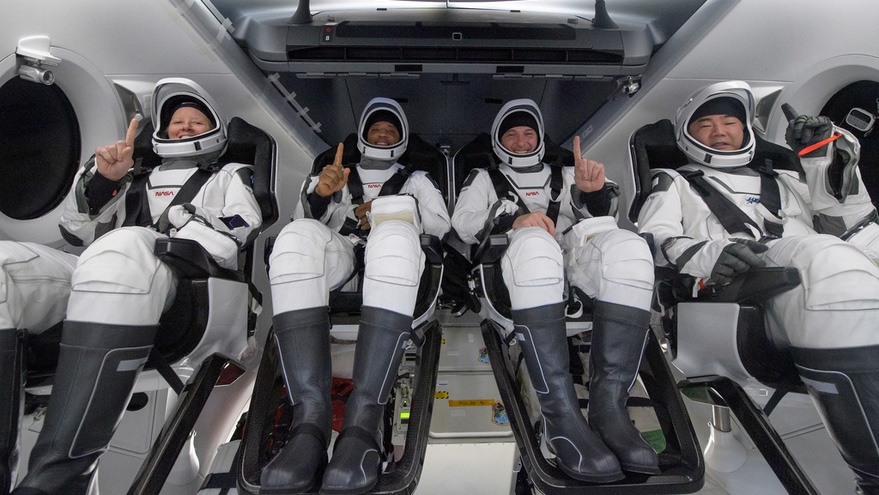Products You May Like
Updated 7 a.m. Eastern after post-splashdown briefing.
WASHINGTON — A SpaceX Crew Dragon spacecraft splashed down in the Gulf of Mexico May 2, returning four astronauts from a five-and-a-half-month stay on the International Space Station.
The Crew Dragon spacecraft Resilience undocked from the station at 8:35 p.m. Eastern May 1. After departing the vicinity of the station and performing a 16-minute deborbit burn, the spacecraft splashed down in the Gulf of Mexico off the coast from Panama City, Florida, at 2:56 a.m. Eastern May 2. On board the spacecraft were NASA astronauts Mike Hopkins, Victor Glover and Shannon Walker, and Japan Aerospace Exploration Agency astronaut Soichi Noguchi.
At a post-splashdown briefing, NASA and SpaceX officials said the spacecraft’s return to Earth went as expected, as did the capsule’s recovery after splashdown. The capsule was hauled on board a recovery boat and the hatch opened within an hour of splashdown.
“They did a phenomenal job getting the crew out of the water very quickly,” Steve Stich, NASA commercial crew program manager, said at the briefing. He credited that to extensive practice by the recovery crew as well as calm seas.
“This was an awesome operation,” said Hans Koenigsmann, senior adviser for flight reliability at SpaceX. “It looked more like a race car pit stop than anything else.”
The splashdown marked the end of the Crew-1 mission, the first operational commercial crew mission. That mission started with a Nov. 15 launch on a SpaceX Falcon 9, with the spacecraft docking with the station a day later.
“This is our first full-up crew rotation mission. We on the NASA side, and I know on the SpaceX side, learned a lot,” Kathy Lueders, NASA associate administrator for human exploration and operations, said. “I don’t know how you could have done this one much better.”
The splashdown was the first at night by an American crewed spacecraft since Apollo 8, which splashed down in the Pacific Ocean after its flight around the moon in December 1968. That was the only other U.S. crewed mission to land in the ocean at night.
The decision to splash down at night was driven by the weather conditions. NASA postponed planned splashdowns during the day April 28 and May 1 because of winds and sea states at its landing zones off the Florida coast. However, weather conditions for this landing were ideal, with waves of about 30 centimeters and winds of five kilometers per hour, well within the limits for a safe landing.
“We debated this switch to night very carefully,” Stich said on NASA TV shortly before the Crew Dragon undocked from the station. “We’re putting the crew and the vehicle down in very benign winds and very benign waves. That’s best for the crew and best for the vehicle.”
Stich said recovery teams got experience with the most recent cargo Dragon mission, CRS-21, which splashed down at night off the Florida coast in January. That spacecraft is similar to the Crew Dragon spacecraft. “We’ve been getting ready for this opportunity,” he said. “When we weighed all those options, it just looked like this was the best time to come home.”
The splashdown marks the end of a busy month on the station that saw two new spacecraft arrive at the station and two depart. The Soyuz MS-18 spacecraft with Roscosmos cosmonauts Oleg Novitsky and Pyotr Dubrov, and NASA astronaut Mark Vande Hei, arrived at the station April 9. The Soyuz MS-17 spacecraft, with Roscosmos’ Sergey Ryzhikov and Sergey Kud-Sverchkov, and NASA’s Kate Rubins, returned to Earth April 17.
Another Crew Dragon spacecraft, Endeavour, launched April 23 on the Crew-2 mission, arriving at the station a day later. It brought to the station NASA astronauts Shane Kimbrough and Megan McArthur, European Space Agency astronaut Thomas Pesquet and JAXA astronaut Akihiko Hoshide. They will remain on the station through late October, when the Crew-3 mission will launch on another Crew Dragon.
Crew-3 will fly a new Crew Dragon spacecraft currently under construction, while Resilience is refurbished for the Inspiration4 private mission scheduled for launch in September. “This was our goal when we set up commercial crew, and honestly we’re very excited to see it taking off,” Lueders said of private human spaceflight. “This is just an exciting first step for that.”
